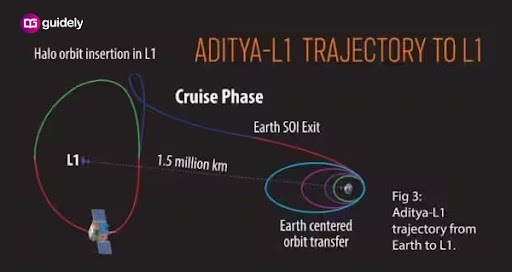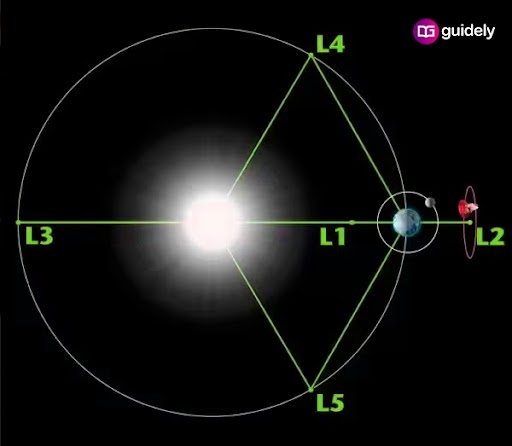Aditya L1 Mission Launch Date Time: ISRO's Sun Mission Full Details
Sep 25 2023
Aditya L1 Mission Launch Date Time: Aditya L1, the first solar mission ever from the Indian Space Research Organization (ISRO), is scheduled to launch on September 2 from Sriharikota in Andhra Pradesh. Days after the momentous success of Chandrayaan-3, which landed on the Moon's south pole last Wednesday, ISRO will launch the Aditya L1 spacecraft. Aditya L1's mission is to put the spacecraft in a "halo orbit" around the Sun-Earth system's Lagrange point 1, or L1, which is located roughly 1.5 million kilometers away from the Earth. ISRO will use the project to investigate how solar activity affects space weather in real time. Understanding "coronal heating, coronal mass ejection, pre-flare and flare activities and their characteristics, dynamics of space weather, propagation of particles and fields, etc.," according to the space agency, is one of the unmanned mission's other main goals. Lagrange Points are regions of equilibrium in space where the gravitational forces of two massive bodies, such as the Sun and the Earth, balance out, creating a region that can be used by a spacecraft to save fuel. They are named after Joseph-Louis Lagrange, a French mathematician who first studied them in the 18th century. According to ISRO, it will take roughly four months to travel the staggering 1.5 million kilometers to the planned mission site. For more details, proceed further and get to know the information about the Aditya L1 Mission launch date time, Aditya L1 Payloads, L1 point distance from the sun, companies involved in Aditya L1 Mission, Aditya L1 Mission Launch Vehicle, etc., in this article.
Aditya L1 Mission Update
Here we have added the latest updates related to the Aditya L1 mission for the reference of the candidates appearing for the examination.
September 19, 2023
September 18, 2023
September 15, 2023
September 10, 2023
September 05, 2023
September 03, 2023
September 02, 2023
Aditya L1 Mission Launch Date Time
Aditya L1 Mission Launch Date Time is 2nd September at 11.50 AM.
Aditya L1 Mission Launch Vehicle
Aditya-L1 Mission Launch Vehicle: The PSLV-XL rocket will be used to launch the Aditya-L1 satellite, which will be India's first observatory in orbit for studying the Sun.
Aditya L1 Mission Trajectory

The PSLV-C57 rocket places Aditya-L1 into a low Earth orbit to begin its voyage. The spacecraft's orbit changes into a more elliptical course after that, and its onboard propulsion directs it toward the L1 point. The spaceship leaves Earth's gravitational field as it travels along this route. Once this line is crossed, the vessel moves into a cruise phase before eventually circling L1 in a large halo orbit.
Aditya L1 Travel Time
Aditya L1 Time to Reach Sun: The spacecraft is expected to arrive at its intended location after a complicated four-month journey.
Aditya L1 Mission Objective
According to ISRO, The Aditya-L1 mission is designed to fulfill the following objectives.
-
Study of the dynamics of the solar upper atmosphere (chromosphere and corona).
-
Study of flares, coronal mass ejections, partial ionization of the plasma, and chromospheric and solar heating.
-
Watch the in-situ particle and plasma environment that the Sun provides, since this information will be used to investigate particle dynamics.
-
The heating mechanism of the solar corona and its physics.
-
Temperature, velocity, and density measurements of the coronal and coronal loop plasma.
-
CME evolution, dynamics, and genesis.
-
Determine the series of events that take place at various layers (chromosphere, base, and extended corona) and ultimately result in solar eruptive events.
-
Magnetic field measurements and field topologies in the solar corona.
-
Drivers of space weather (solar wind dynamics, composition, and origin).
What are Lagrange points?

Lagrange points are places in space where two celestial bodies' gravitational pull creates pockets of gravitational equilibrium, such as the Sun and Earth. By doing so, the spacecraft can maintain its current position without using fuel.
In a system like the Earth-Sun system, there are five Lagrange points, numbered L1 to L5. The L1 and L2 points, which are the nearest to the planet, are suitable observational study locations.
About Aditya L1 Payloads
The spacecraft is equipped with seven payloads that use electromagnetic, particle, and magnetic field detectors to study the photosphere, chromosphere, and the Sun's outermost layers (the corona). Four payloads use the unique vantage point L1 to observe the Sun directly, while the remaining three payloads conduct in-situ particle and field studies at the Lagrange point L1. This allows for significant scientific research on the propagation of solar dynamics in the interplanetary medium.
The Aditya-L1 spacecraft's instruments are set up to primarily observe the chromosphere and corona of the sun. At L1, in-situ instruments will monitor the immediate environment. There are a total of seven payloads aboard, four of which perform solar remote sensing and three of which perform in-situ observations.
The Sun's atmosphere will be imaged by the four remote sensing payloads using visible, ultraviolet, and X-ray light.
-
The solar corona will be seen and its dynamics will be researched using the Visible Emission Line Coronagraph (VELC).
-
The photosphere and chromosphere will be imaged by the Solar Ultraviolet Imaging Telescope (SUIT) in both narrow and broad ultraviolet wavelengths.
-
The soft X-ray radiation from the Sun will be investigated by the Solar Low Energy X-ray Spectrometer (SoLEXS).
-
The hard X-ray emission from the Sun will be investigated by the High Energy L1 Orbiting X-ray Spectrometer (HEL1OS).
The three in-situ payloads will gauge the solar wind's makeup, behavior, and magnetic field.
- The solar wind's dynamics and composition will be evaluated by the Aditya Solar Wind Particle Experiment (ASPEX).
- The solar wind's plasma characteristics will be measured by the Plasma Analyzer Package for Aditya (PAPA).
- The magnetic field present in the solar wind will be measured by the Advanced Tri-axial High-Resolution Digital Magnetometers.
Aditya L1 Mission Companies Involved
Companies Involved In Aditya L1 Mission: As part of its collaboration with the Indian Space Research Organization (ISRO), Larsen & Toubro (L&T), which constructed essential equipment for Chandrayaan, is also working on the Aditya-L1 mission.
FAQs - Aditya L1 Mission
Q. When is Aditya L1 launching time?
Aditya L1 Mission Launch Date Time is 2nd September at 11.50 AM.
Q. Is Aditya L1 going to Sun?
Yes. Aditya L1 is the first ever Sun mission by ISRO.
Q. What is L1 in Aditya Mission?
The first Indian solar mission to orbit in the class of an observatory, Aditya-L1 is designed to study the Sun. The spacecraft will be positioned in a halo orbit 1.5 million kilometers from Earth, at the Lagrangian point 1 (L1) of the Sun-Earth system.
Q. What is the purpose of Aditya-L1?
The Aditya-L1 spacecraft is equipped for remote observations of the solar corona and in-situ observations of the solar wind at L1(Sun-Earth Lagrange point), located approximately 1.5 million kilometres from Earth.
Q. How much distance will Aditya-L1 cover?
The spacecraft will travel 1.5 million kilometres from the Earth over the course of four months.
Q. Where will Aditya-L1 land?
There is a common misconception that this spacecraft will touch down on the Sun. The purpose of this essay is to clarify that Aditya L1 will not touch down on the Sun. Instead, it will settle into a halo orbit 1.5 million kilometers from Earth's Lagrange Point 1 (L1) in the Sun-Earth system.
Q. What is Aditya-L1 solar mission?
India's first solar mission, Aditya-L1, is a space-based observatory for studying the Sun. The spacecraft, which carries seven payloads, will study the Sun's photosphere, chromosphere, and outermost layers.
General Awareness Smart Analysis (Smart Quiz 2.0)
- Get Weekly 4 set Test
- Each Set consist of 50 Questions
- Compare your progress with Test 1 & 2 & Test 3 & 4
- Deep Analysis in topic wise questions
Super Plan
- Bundle PDF Course 2025
- Premium Bundle PDF Course 2024
- Bundle PDF Course 2023
- Ultimate Bundle PDF Course 2022
- English Bundle PDF Course
- Insurance & Financial Market Awareness Bundle PDF Course
- Descriptive Papers for Bank & Insurance Exams
- Interview Bundle PDF Course
- General Awareness Smart Analysis
- All Bank Exams Video Course*
- Platinum Package (Test Series)
- All Premium eBooks
- Interview Courses are not included*
Premium PDF Course
- Bundle PDF Course 2025
- Premium PDF Course 2024
- Prime PDF Course 2023






